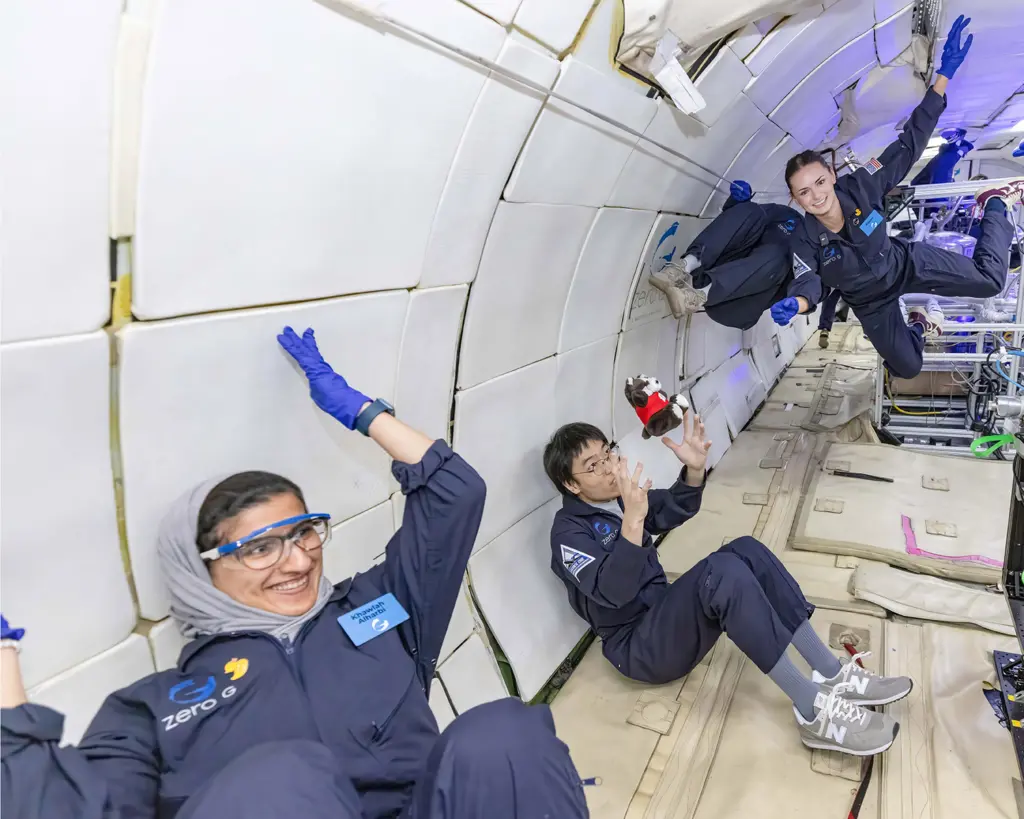In the end, Rayne Wolf could hardly bear to look at the monitor attached to the microscope she and her labmates had set up in a hangar at Fort Lauderdale-Hollywood International Airport.
Wolf and her fellow University of Wisconsin-Madison graduate students had spent the past two-plus weeks in the muggy Florida heat finishing final preparations for a series of parabolic test flights to validate their 3D printing technology in a zero-gravity environment.
But the first two flights—roughly 40-minute jaunts comprised of alternating 30-second periods of zero-gravity and 2G conditions (also known as “vomit comets” for their tendency to make passengers sick)—hadn’t gone as planned. The printer’s stages had stubbornly refused to move, leaving the students and their advisor, Industrial and Systems Engineering Assistant Professor Hantang Qin, with one final shot. They spent the week leading up to their third flight troubleshooting any and all potential causes during 12- to 15-hour days.
“A lot rides on these experiments,” says Wolf, a PhD student from Potosi, Wisconsin, and one of the team leads on the NASA-funded project.
The group’s perseverance paid off: Qin’s lab made history in March 2024 by successfully 3D printing RAM device units in zero gravity—the first time it’s been done.
NASA is interested in developing in-space manufacturing capabilities for electronic components such as semiconductors, actuators and sensors. That would offer a viable option for making repairs during longer-duration space missions, without needing to transport replacement parts.
Since traditional 3D printing relies upon gravity to extrude material from a printer nozzle, in-space printing requires a different approach. Qin’s lab has developed an alternative called electrohydrodynamic (EHD) printing, which applies electrical force to drive the flow of liquid materials through an extremely thin nozzle that’s 30 micrometers in diameter.
 Images courtesy of Qin lab.
Images courtesy of Qin lab.
“Under this small scale, the surface tension will prevent the liquid from flowing out from this nozzle,” says Qin, whose group is leading the collaboration with researchers from Iowa State University, Arizona State University, Intel and other industry partners. “And then we apply this electrical force to break out of this surface tension force.”
Qin, who brought his work to UW-Madison in 2022, says EHD printing technology has advantages beyond its ability to function in zero-gravity environments. With traditional 3D printing, nozzle size essentially determines droplet size.
“But using our printing system, we can make the droplet way smaller than the size of nozzle,” he says. “Given a 2-micrometer nozzle, we can make a nanoscale pattern. That’s the huge advantage of this.”
After pinning down an issue with their printer’s stage calibration sensors caused by the vibrations of the plane’s engine and rewriting some of their system’s code to compensate (Pengyu Zhang, a graduate student in electrical and computer engineering, was literally writing code in zero-gravity), the team capitalized on its final test flight. Under the manual control of Wolf and Jacob Kocemba (BSBME ’23, now a graduate student at the University of Illinois), the lab’s EHD printer successfully produced more than a dozen units with zinc oxide, a semiconducting ink, and a half dozen more with polydimethylsiloxane, an insulating polymer ink.
Still, while the researchers could see their printer was working as they floated around the plane’s cabin, they couldn’t confirm their results on the micro- and nanoscales until that fateful postflight huddle around the microscope.
“We got a good feeling when we were in the air and the stages were working,” says Khawlah Alharbi, a first-year PhD student from Saudi Arabia who was in the air for two of the test flights. “When the results came out, we were really satisfied and happy and excited to move on with our research.”
The researchers are planning to return to Florida in August and November 2024 for two more test flights, during which they’ll attempt to incorporate their EHD technology into an industry partner’s multi-tool 3D printer, and then progress from printing individual units to full semiconducting devices.
If they can meet those project milestones, then they hope to launch their technology for testing aboard the International Space Station.
“If we can send this up to the ISS,” says Liangkui Jiang, a fifth-year PhD student from China who’s worked on the project since conception, “it would be a happy ending.”
This research was supported by NASA (award numbers 80MSFC23PA012 and 80NSSC2XK1188).
UW-Madison engineers experience weightlessness in zero-gravity environment